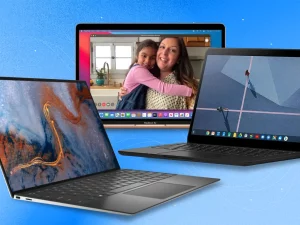It would be best to determine what you require before spending money on a laptop or persuading your parents to purchase one.
There is a tonne of choices available, and no one solution suits all situations. So, consider these specifications before spending much money on something that appears excellent.
When looking for a new laptop for college, the first thing to consider is how you’ll use it going forward. Given how quickly technology advances yearly, a computer that can accommodate new applications and programs is a good option. Buying a PC with space for future, more advanced technology is called “futureproofing” your purchase.
Asking yourself these queries will help you focus your options.
- What apps or programs are necessary for your classes?
- What area of study or subject most interests you?
- Do you enjoy playing computer games?
- Do you use video conferencing to communicate with loved ones?
- Do you like producing your material, such as podcasts and videos?
Related Read: How to speed up your slow PC or laptop
1. Budget
When you buy, this is the most crucial information you should know. Your options are constrained by what you can pay, after all. Be at ease, though! Laptop prices range these days widely.
Choose which spec is to you if you’re on a tight budget. What do you value more, screen capacity or portability? Or is an extended battery life required? Consider your activities, course of study, and way of living. You will then be able to choose the ideal notebook for you. You can purchase inexpensive, small fundamental gadgets.
However, enormous robots are available that will carry out your every request. In addition, there are a variety of laptops in all sizes and forms between the two. Your options will significantly reduce once you know how much you can spend. Then, you can select the best device based on the specifications and requirements.
2. A battery’s life
A laptop with a long battery life should be one of your top priorities since you’ll travel around a lot while in school. In addition, using your computer in class can be challenging (and possibly disruptive) if you need to find an outlet during a lesson because you run out of battery power.
You could carry a high-capacity power bank to recharge your devices. Still, the bulk and weight will be an inconvenience. However, one thing to remember is always to take manufacturer-provided battery specifications with a grain of salt. This is due to manufacturers testing their equipment in a facility or under ideal operating conditions.
Therefore, before making a choice, study or watch a few reviews that demonstrate a laptop’s performance in actual use. The lifespan of a laptop battery varies depending on how you use the computer; it’s best to use vendor specifications as a general benchmark.
3. Size and Weight
Consider its weight and size if you plan to take the laptop around. After all, you must bring books, notes, a smartphone, pens, and other supplies to school.
Its mass and density may therefore play a significant role in your decision. For instance, a lightweight 13″ laptop with just the right amount of power is preferable to a bulky 17″ gaming laptop that will make you tired at the end of the day if you frequently travel between various campus buildings.
Laptops with two functions are very flexible without requiring any trade-offs. With the performance of a PC and the fun of a tablet combined in one stylish device, 2-in-1s give the best of both worlds.
Two distinct kinds of 2-in-1 laptops exist: convertible and detachable.
Convertibles
- Keyboards can rotate, twist, or turn while remaining fixed.
- Flip to show or share content in “tent” or “stand” modes.
- For “tablet” mode, fold in half completely.
Excellent for students who value productivity and put in a lot of work but also want tablet capability for entertainment.
Detachable
- Allow for lightning-fast switching between laptop and tablet settings.
- Provide a tablet-only experience when the keypad is removed.
- Perfect for web users who occasionally need to write.
Read Also: Top 9 gaming laptops under $1500 for 2023
4. Processing Strength
You don’t need to worry about a laptop’s technical specs if you’re looking for one for everyday tasks like word processing and web browsing.
A workable computer with an Intel Core i3 or AMD Ryzen 3 CPU, 8GB of RAM, and a 512GB SSD should be adequate for education. However, you should invest in more powerful machinery if your course requires specialized software and equipment, such as video editing, 3D rendering, and particle simulations.
Naturally, it still depends on your money. Still, a strong processor and GPU will let you handle more demanding applications.
5. Storage
The “long-term memory” on your laptop is where you put images, videos, and other information you want to keep around for a while. Although it might not be used frequently, the data is still essential to save, keep, and use when required.
Hard disc drives (HDD), solid-state drives (SSD), or even a combination can all be used to store this info. Since they have no moving parts, SSDs generally offer quicker data access and startup times. They are also very dependable and long-lasting. Nowadays, the majority of computers have at least 256GB of storage. While most students will be OK with this, you may want to get more if you are interested in programming, film editing, or photography.
These programs demand more room. Even 1TB is only sometimes enough to store your data and programs. Consider purchasing more storage space or using a cloud storage service to avoid toting around a portable external drive.
6. Ports and a Webcam
Today’s laptops frequently have few ports, fragile and light ones. And if you’re a student, you should be cautious of this.
While some people only need three or four USB-C ports, an HDMI port is still required to link to a projector or an external display. USB-A ports may also be necessary to connect your outdated equipment, such as an external mouse. When you need to participate in a virtual conference, you might face some challenges if your laptop lacks a webcam. Using your phone or an external webcam is inconvenient for seeing the persons you are speaking to.
It would help if you were aware of laptops that lack a built-in camera because they exist. You can attach a wide range of devices to USB ports, the most popular and well-known connectivity ports, including external hard drives, cameras, keyboards, mice, and more.
The most recent version, USB 3.1, provides 10 Gbps transfer speeds, which are faster. Below are important ports to the laptop
Thunderbolt 4 ports
Up to this point, Thunderbolt 4 offers quick connection and transfer speeds.
Ethernet ports
Using an Ethernet port, you can directly link your laptop to a wired network. Due to the prevalence of Wi-Fi, these ports are often absent from computers.
SD card reader or SDHC card reader Port
However, suppose the Wi-Fi coverage on campus is spotty. In that case, you can connect to the internet using an Ethernet cable and one of these sockets. If your preferred model lacks an Ethernet port, USB-to-Ethernet adapters are readily accessible.
HDMI, VGA, and DVI Ports
These ports, such as HDMI, VGA, and DVI, let you link to displays or other screens, like an HDTV or an external computer.
This port accepts memory cards for digital cameras. It is also called an SD card reader or SDHC card reader. This facilitates the fast and straightforward transfer of digital photos to your laptop. Having an audio port on your notebook is also helpful. In this manner, you can enjoy crystal-clear audio when listening to music or conversing with others using connected headphones.
However, portability is more important to you. Then, you can choose a USB hub with an audio port to get the required functionality.

7. Display
Consider getting a larger screen if you anticipate sitting in front of your laptop for extended periods, such as when composing papers or programming.
Because you have to squint to see fine details on a tiny surface, small screens can be straining on the eyes. So think about installing a 24″ display for a small, portable computer in your room. Then, to have a larger display while learning, you can plug your laptop into it. Later, your eyes will appreciate you.
8. Software
When you purchase most laptops, Windows, macOS, or Chrome OS are already installed, but that’s about it. You’ll need productivity software and other things to make your computer usable. An office suite is a necessary tool for all students.
Although Google’s office software is free, it is frequently utilized online. Instead, consider Microsoft Office 365 or even one of the many Microsoft Office options to have a more reliable offline experience. In addition, lots of places give students deals!
9. Prioritize performance
The speed you’ll require depends on how you use your laptop. Video games and using resource-intensive software like Adobe Premiere Pro* demand a lot of processing capacity from the CPU.
10. Keyboard
Not just authors and gamers think a laptop’s keyboard is the most crucial component. Consider that you will use the laptop’s keypad more than any other component, so you should look for one that is cozy, simple to use, and has a satisfying spring or tactile feel. Do you need or prefer a keypad with backlighting?
Think about crucial location and size as well. Want a 10-key keyboard, please? Do you like the usual placement of all the keys? Make careful to experiment with various keyboards. Start a word processor, then start typing. If a laptop keyboard isn’t suitable for you, you may notice it immediately.
11. Touch-pad
Many people use a laptop’s touch-pad instead of a cursor to complete tasks. Although, when traveling or working in a small area like a lecture theater or café, a comfortable, simple touch-pad is essential, when deciding whether you want a single, large touch-pad or separate left- and right-click buttons, think about the size and location of the touch-pad. Some touch-pads even have designs and textures to provide a tactile experience,
12. Graphics
Most laptop models use a CPU with an integrated graphics chipset as their source of electricity. This means there is no need for a separate graphics card because the graphics are truly integrated into the processor.
With the increased capability of these integrated graphic technologies, you can stream, play popular games, and support up to three different displays.
However, you should research specialized graphics or GPU if you enjoy gaming or making movies. In terms of the cost of the laptop, dedicated graphics are significantly more costly than integrated graphics but are also more powerful.
13. RAM
This phrase will be frequently used as you look for a laptop for education. RAM stands for Random Access Memory. Recently used data is momentarily stored in RAM for later fast access.
Consider it the information you can recall off the top of your head because you frequently use it, and your brain has quick access to it. A computer will appear faster for you if more RAM is accessible. A notebook with 8GB to 16GB of RAM would be ideal.
Conclusion
Finding the ideal laptop for your college career can set you up for success, even though it may seem like a lot to recall. Consider what you’ll need most from your college laptop regarding size, weight, computing power, and storage when creating a checklist using the features in this article.
Consider the weight and thickness of your new notebook when deciding between these various form factors. A long walk across campus can become uncomfortable when carrying a large laptop. Thank goodness modern laptops are accessible in multiple sizes and weights. This brings us to your following point: the laptop’s screen. In general, your laptop’s battery life will decrease the larger its screen is and the bulkier the model. This is because smaller laptops and Ultra-books use processors with the reduced voltage that are specially made to provide longer battery life.
Visit vendor websites or read online reviews to learn more about battery life. Mid-sized to larger laptops typically offer four to six hours of battery life. In comparison, ultra-portable versions can last up to ten hours.

